Acer Aspire S7 Ultrabook: Acer’s Best Foot Forward
by Jarred Walton on January 7, 2013 4:30 AM EST- Posted in
- Laptops
- Acer
- Intel
- Ivy Bridge
- Aspire S7
- Ultraportable
- Ultrabook
Display Quality
Now we get to the one area where so many laptops fall short: the display. I’m a bit torn on the overall LCD experience, because on the one hand it’s the best LCD I’ve ever seen in an Acer laptop, but on the other hand there’s still room for improvement. Let’s start with the good news first: Acer is using a 1080p IPS touch screen, which means great viewing angles (which are necessary for any tablet-like experience). Contrast and maximum brightness are also good.
So what’s the problem? The problem is that there’s a reddish cast to the display and the color gamut as well as color accuracy—even after calibration—are not as good as we would like. Apple is still the company to beat for out-of-box color accuracy, and area they’ve greatly improved on with their latest devices.
We’ve been talking about LCD quality in mobile devices for over six years, and finally it looks like companies are heading in the right direction, but we want to get there faster. The ideal would be to have every display calibrated at the factory to provide relatively accurate colors, but barring individual calibration of panels, we’d be happy with the general LCD family targeting a 6500K white point with a sub-3.0 average DeltaE on the Gretag MacBeth color chart. That might sound like we’re asking for professional display quality, but let me point out that: 1) it’s now 2013 and professionals have had the tools to do this for over two decades; 2) we’re looking at a minimum $1400 MSRP laptop, so this isn’t a budget-friendly device to begin with.
Most consumers wouldn’t recognize accurate colors in the first place, and sadly when you’re at the store and a salesperson has two displays next to each other in the bright retail lights, many people will prefer the less accurate but brighter colors that the S7 currently delivers. Even without perfect colors, however, the Acer S7’s AU Optronics B133HAN03.0 v1 panel is pleasing to use. Here are the numbers.
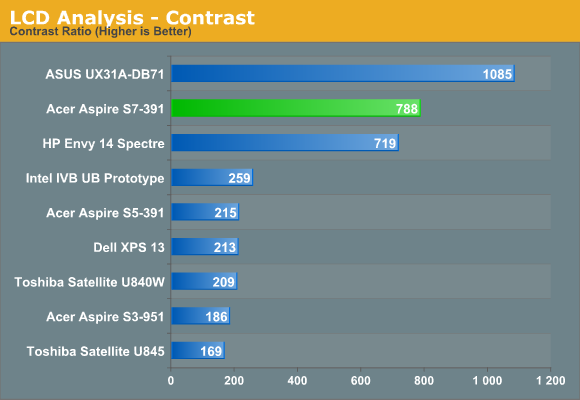
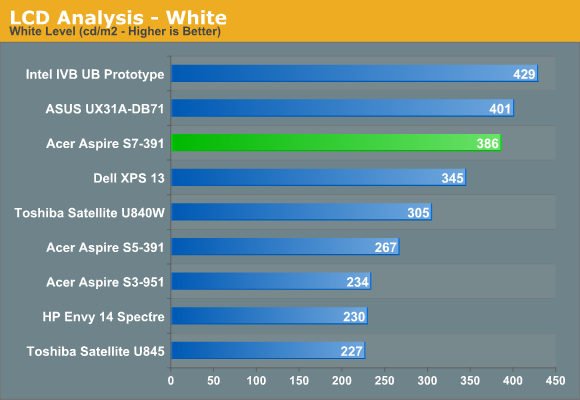
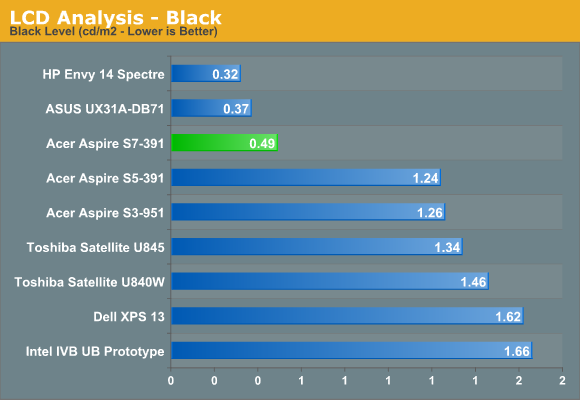
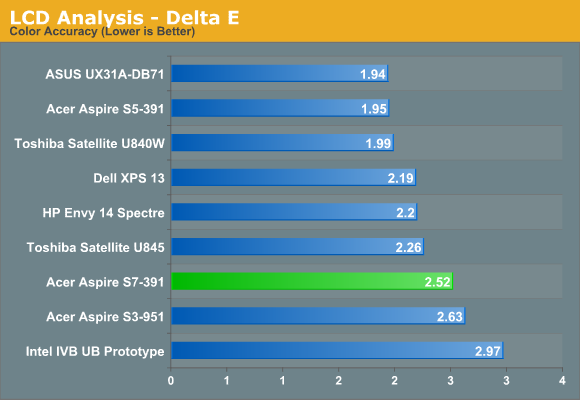
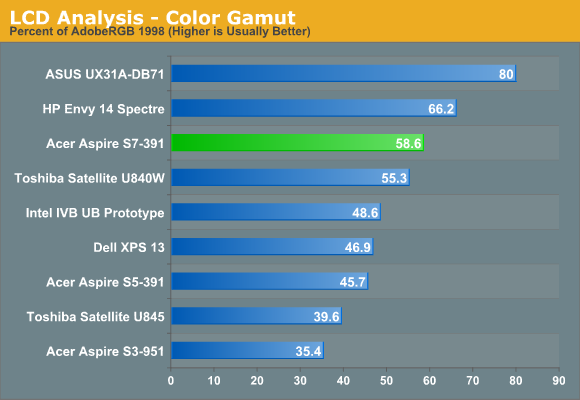
Contrast and brightness are good, though we’ve seen better. As I noted above with the colors being somewhat off before calibration, that carries over post-calibration with an average DeltaE that’s still around 2.5—ideally we’d like to see well under 2.0 for a quality display. The 58.6% color gamut is also less than what we’d like to see, which at a minimum would be the full sRGB color space (around 69%). What’s more, we chose the best calibration result for the above charts; with some of the other targets, the color gamut is a dismal 36%. If you’re okay with the native white point, you get a higher gamut, but if you want to target 6500K or D65, expect to see less than ideal results.










53 Comments
View All Comments
rarson - Thursday, January 10, 2013 - link
First of all, it depends on the type of accident. I can guarantee you that a head-on collision with a wall at, say, 30 mph will be safer in a Smart Car than an Oldsmobrick.The fact of the matter is that when it comes to protecting the passenger, crumple zones and safety cages are more important than mass. Today's cars are designed to absorb the energy of the crash, to soften the impact on the passenger. Older cars were designed with the mentality that if the car survived mostly unscathed, then the passenger would as well, which is obviously incorrect. If safety is your primary concern, then you're better off looking at crash testing than vehicle size or weight. But the absolute best way to increase your safety is to become a better driver.
Tech-Curious - Thursday, January 10, 2013 - link
It's a matter of mass and size. Your guarantee is preposterous, because a Smart Car has precious little space within which to crumple, without also crumpling the people inside of it. The size of the wheelbase, the cabin, and yes, the mass of the vehicle are all important.
I've been in a head-on collision in a compact car with a much heavier object (a semi-truck). Trust me when I say that I'm lucky to be alive; if I hadn't swerved at the last second, I would have been vaporized, because the truck literally drove through the right side of my engine compartment, and didn't come to rest until its front bumper was sitting on my passenger seat.
Thank god no one was sitting there. The truck's damage? A cracked headlight.
Now, if I had been involved in the same accident in an Oldsmobrick, as you call it, the car would much more likely have kept something approaching its original shape. A passenger or I could have died from the internal trauma caused by the savage stop; that's true -- but the passenger would have died in more-or-less one piece.
Let's not kid ourselves: The Smart Car is little more than a roofed motorcycle, for all the protection it offers your body. Many modern cars are safer than their (often heavier) ancestors, but I chose the Smart Car because it represents an extreme, and I thought (erroneously, as it happens) that the extreme example would illustrate the point without courting controversy.
And yes, good driving habits comprise the best safety measure available -- but it's a mistake to assume that you're ever 100% in control of any situation on the road. The essence of safe driving is to understand that you don't have that control, to minimize your risk by putting yourself into the best position to react to sudden hazards. Even so, not all hazards are avoidable.
Tech-Curious - Thursday, January 10, 2013 - link
Oh, and with regard to crash testing, you have to be very careful. Tested safety ratings might rule out weight and size: for instance, the Smart Car recently got a safety rating similar to the Trailblazer's -- but you'd have to be out of your mind to conclude that both vehicles are equally safe.The Trailblazer is simply at the same level, relative to its analogues, as a Smart Car. A couple of statements from (or paraphrases of) the president of the Insurance Institute from Highway Safety follow:
(From http://www.msnbc.msn.com/id/24599768/ns/business-a...
(from http://usatoday30.usatoday.com/money/autos/2009-04...
(from http://usatoday30.usatoday.com/money/autos/2009-04...
And finally, the tale in pictures. Trailblazer: http://media.caranddriver.com/images/media/191279/...
Smart Car: http://node1.ecogeek-cdn.net/ecogeek/images/storie...
rarson - Thursday, January 10, 2013 - link
"Once you get to the point where the price isn't as much of an issue (especially for something you'll be using for 4-5 years) the enjoyment of using something that has high-quality interface points (monitor, keyboard, etc.) quickly overcomes the cost difference."In that case, the Acer (and the Macbook Air) fail completely. I've got a $350 Trinity laptop that I'm using right now that has a much better keyboard than both of these, and even my old PII Compaq laptop is DRASTICALLY better. I understand what you're saying about touchpads (the laptop I'm using definitely has some quirks that can make the touchpad frustrating), but I find it laughable when people call these devices "high quality" when they have such terrible keyboards.
rarson - Thursday, January 10, 2013 - link
1) Uh, every device that I've tried feels fragile in my hands due to the actual thickness, not the construction or materials. That's why I said I "feel" like I'm going to break the thing.2) Well that's just absurd. Anyone can easily see the value of a Mercedes. You can't tell the difference between a car with solid body construction and quality sound deadening? It's a pretty marked difference between, say, a typical economy car. You don't seem to understand the difference between seeing the value and actually desiring it.
There's no exceptional build quality here. The device isn't going to last longer or significantly outperform a comparably equipped, but much cheaper laptop. All you're getting is a decent display (with the added cost of touch), a slimmer chassis, and an unjustifiably higher price. So where exactly is the value proposition here?
The0ne - Monday, January 7, 2013 - link
This is an Ultrabook laptop. These are usually not cheap to begin with because they are Ultrabooks. Why are people comparing these to notebooks that are not even in the same class? These are not even in the same class as business notebooks as well. Subjectively, these are expensive because they are light and thin. Most of the readers here won't even consider buying one to be honest or may have never own an ultrabook before. The market for these are business travelers where they need the light weight and thinness to carry it around for long periods of time.I just don't understand why people would complain about something that they don't begin to comprehend what it is and what market it is aimed at.
rarson - Thursday, January 10, 2013 - link
You're right, I don't comprehend what market these are aimed at, since a regular laptop is only about a pound heavier than this thing, and might actually offer a decent keyboard and slightly larger screen real estate, things that I'm pretty sure would be far more important to the average businessman than "thin and light," at a significantly lower price, no less.Perhaps you could explain to me why a businessman would need a touchscreen on a laptop, or 1080p resolution in a 13" screen.
You said it above: "These are usually not cheap to begin with because they are Ultrabooks." Right, they are'nt cheap because they're marketed as expensive devices. I'm sure it costs more money to make the thinner, lighter chassis. But that doesn't mean that it makes sense to pay more for it.
jabber - Monday, January 7, 2013 - link
.....did we get a indication of what this machine is like out of the box?In other words -
1. How long did it take from first switch on till actually being able to use it properly?
2. How much crapware was installed and how long did it take to uninstall?
I have known Acer laptops (and others from similar companies) to take a couple of hours messing around till you can actually use them. I love the ones that force you to burn a set of recovery disks at start up and threaten thats its a once in a lifetime deal.
bobjones32 - Thursday, January 10, 2013 - link
I posted elsewhere in this thread with my impressions, but my wife purchased this from a Microsoft Store. That means it comes with a Signature image, so no bloatware, and ready to use straight out of the box.The thing turned on instantly, set up quickly, and she was using it fully within just a few minutes.
thesavvymage - Tuesday, January 8, 2013 - link
I seriously do not understand on having the "thinnest" laptop you can have. You dont hold it in your hands, it sits on your lap. The screen size and overall volume are what matters the most (for bulk). This laptop is .5" thick. If they even increased it to .7", they couldve added a bigger batter and better cooling, and it wouldnt even seem that different to anyone without a milimeter caliper.